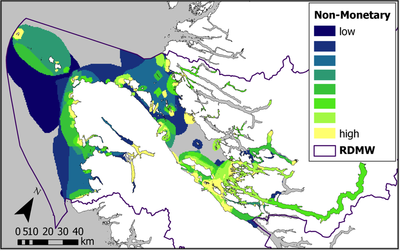Diverse sustainability topics with common themes
- I heavily rely on visuals for my research, including maps, aerial footage from my Mavic Pro2 drone, and visualizations, particularly of renewable energy infrastructure. I am currently exploring building 3D models of renewable energy landscapes with my drone footage.
- I have experience with various methods including semi-structured interviews, choice experiments and surveys.
- My research is synthetic, in that it spans disciplines and integrates topics. For example, my current research explores ways in which utility scale solar can provide ecosystem services and benefits to biodiversity, which are largely ecological questions, and I'm exploring how different types of people perceive these design modifications.
Cultural ecosystem services
Ecosystem services are benefits from nature to people (e.g, fisheries, recreation, fresh water). Cultural ecosystem services can be defined as "ecosystems' contributions to the non-material benefits (e.g., capabilities and experiences) that arise from human–ecosystem relationships" (Chan et al., 2012) (e.g, sense of identity tied to a natural place, social connections enhanced by spending time in nature with friends or family). I helped develop and test an interview protocol in which participants are asked to reflect on how ecosystems are connected to their livelihoods as well as various social and cultural values. These mixed methods involved the qualitative identification and characterization of ecosystem services and participatory mapping of the location of these benefits from nature. We also collected the quantitative assignment of relative weights to particular areas associated with monetary and non-monetary value as well as perceived environmental threat.
This research gave rise to these publications: What matters and Why? Ecosystem Services and their bundled qualities; Navigating coastal values: Participatory mapping of ecosystem services for spatial planning; A Protocol for Eliciting Nonmaterial Values Through a Cultural Ecosystem Services Frame and Where are Cultural and Social in Ecosystem Services? A Framework for Constructive Engagement.
This research gave rise to these publications: What matters and Why? Ecosystem Services and their bundled qualities; Navigating coastal values: Participatory mapping of ecosystem services for spatial planning; A Protocol for Eliciting Nonmaterial Values Through a Cultural Ecosystem Services Frame and Where are Cultural and Social in Ecosystem Services? A Framework for Constructive Engagement.
Landscape visualization with renewable energy infrastructure
Intuitive and emotional reactions to visual impacts can drive support or opposition to changes in land and seascapes. To evaluate reactions to a hypothetical wind farm, I built a custom animation of a wind farm in New Zealand. I created it with Google Earth and Sketch Up with assistance from Evan Jones for research on how people perceive risks to ecosystem services (i.e., benefits from nature to people) from an offshore wind farm.
Hypothetical offshore wind farm location: Farewell Spit, New Zealand
For research purposes, I chose this location for a hypothetical offshore wind farm because it has strong winds and shallow waters. This area, however, is habitat for thousands of seabirds, which could be impacted by wind energy development.
For research purposes, I chose this location for a hypothetical offshore wind farm because it has strong winds and shallow waters. This area, however, is habitat for thousands of seabirds, which could be impacted by wind energy development.
Regenerative design
According to Lyle (1996), regenerative design has:
- System operations integrated with natural and social processes
- Minimal reliance on fossil fuels and synthetic chemicals
- Minimal use of non-renewable materials
- Sustainable use of renewable resources for operation
- Associated waste products re-assimilated without environmental harm
Offshore wind farms depicted with various artificial reef qualities. These images were used in my choice experiment to identify features that drive wind farm preferences.
References
Chan, K. M. A., Satterfield, T., & Goldstein, J. (2012). Rethinking ecosystem services to better address and navigate cultural values. Ecological Economics, 74(C), 8–18.
Lyle, J. T. (1996). Regenerative Design for Sustainable Development. New York: John Wiley & Sons.
Chan, K. M. A., Satterfield, T., & Goldstein, J. (2012). Rethinking ecosystem services to better address and navigate cultural values. Ecological Economics, 74(C), 8–18.
Lyle, J. T. (1996). Regenerative Design for Sustainable Development. New York: John Wiley & Sons.












